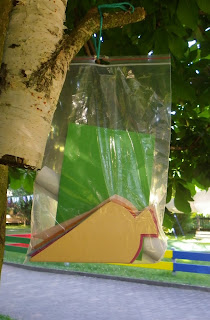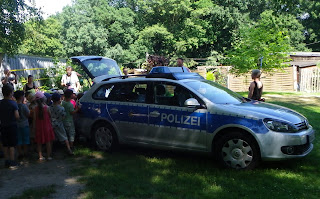While Americans are hitting the back-to-school sales at a fever pitch, students across Germany will return to hit the books sometime between the beginning of August and the beginning of September. The first day of school for former kindergartners in Germany is a cause for celebration, a ceremony, and gifts. Sarah Reader, Beaverton native and current resident of Mittweida, Germany, tells us more.
German children gear up for their first day of school for
almost a year, during which time they have preschool lessons in
kindergarten. Kindergarten in Germany is
not compulsory and could be considered a blend of daycare and preschool rather than
the first year of school as it is in the United States. German children can attend kindergarten
between the ages of 3 and 6. The
preschool year of kindergarten for the five year olds includes weekly
school-like lessons, during which the children work on projects; learn about
letters, numbers, and words; and go on excursions. Near the end of the year the children also
visit the nearby elementary schools which they will attend in the approaching
school year. They meet their teachers,
see their classrooms, and even sit at real school desks for the first time, all
the while becoming more and more excited about the next phase of their
lives: school.
But German children don’t just get on the big yellow bus on the first day of school and ride to their elementary school: in fact, there are no big yellow school buses. The first day of school for the incoming first grade class isn’t even on a Monday, but rather a Saturday! Saturday school may sound depressing, or even like a punishment, but it’s a cause of great excitement for Germany’s six year olds and their families. Each new first grade class at the local elementary school has a time slot on the Saturday before the new school year begins. Families and their new first graders file into the school auditorium; are treated to a skit by older students who will be entering second, third, and fourth grades; and listen to a speech by the principal. The new first graders even bring their backpacks to school and after the show they accompany their new teacher to their classroom. There, a symbolic class period is held. When the ceremony finishes, the families and children are reunited, and the children then receive their “Zuckertüten.” Literally translated, the Zuckertüte is a sugar bag; it’s actually a cone-shaped cardboard package bursting at the seams with sweets and school supplies and is usually topped with a new toy or stuffed animal for the new pupil. It is presented to the children individually by their new teacher at the end of their symbolic first day of school. Another name for it is “Schultüte,” or school bag. This name is used in the western states of Germany, but this school bag is only used on the very first day of first grade!
But German children don’t just get on the big yellow bus on the first day of school and ride to their elementary school: in fact, there are no big yellow school buses. The first day of school for the incoming first grade class isn’t even on a Monday, but rather a Saturday! Saturday school may sound depressing, or even like a punishment, but it’s a cause of great excitement for Germany’s six year olds and their families. Each new first grade class at the local elementary school has a time slot on the Saturday before the new school year begins. Families and their new first graders file into the school auditorium; are treated to a skit by older students who will be entering second, third, and fourth grades; and listen to a speech by the principal. The new first graders even bring their backpacks to school and after the show they accompany their new teacher to their classroom. There, a symbolic class period is held. When the ceremony finishes, the families and children are reunited, and the children then receive their “Zuckertüten.” Literally translated, the Zuckertüte is a sugar bag; it’s actually a cone-shaped cardboard package bursting at the seams with sweets and school supplies and is usually topped with a new toy or stuffed animal for the new pupil. It is presented to the children individually by their new teacher at the end of their symbolic first day of school. Another name for it is “Schultüte,” or school bag. This name is used in the western states of Germany, but this school bag is only used on the very first day of first grade!
 | ||||
| My own son Wilhelm with his Zuckertüte. |
 |
| All of the Zuckertüten for the incoming class. |
The most involved Zuckertütenfest I have heard of takes place at Kindergarten Goethehain in Mittweida, Germany, and I was lucky enough to accompany this year’s preschool group on their Zuckertütenfest excursion this year. The excitement starts several weeks before the actual celebration, when the children choose a tree on the kindergarten playground to water with sugar water, dreaming of big Zucktertüten. Every day the preschoolers check the tree, until one day, blossoms appear!
 |
| One of the first blossoms on the Zuckertütenbaum. |
 |
| The first tiny Zuckertüten appear. |
 |
| One week later, they've grown in size. |
Finally, on the day of the big
event, the children arrive at the kindergarten in the morning, have breakfast
together, and then they check the tree.
The Zuckertüten have disappeared, and a bag with a letter and a treasure
map is all that’s left.
 | |
| A treasure map was left in place of the stolen Zuckertüten. |
The hunt begins: Karl-August left the children a letter and a
treasure map, now it’s time for the preschoolers to put the things they learned
over the past year to the test and see if they can solve the tasks presented
along the way in order to ultimately recover the stolen Zuckertüten. First, the map is examined and the kids check
if they recognize any of the places that the sly fox has sketched out for
them. There are several stations
throughout the town and into the nearby countryside, all places the children
have visited before and recognize on the map.
The group starts at the kindergarten at 8:30 in the morning and embarks
on an all-day hike. The children check
the map to find the first station on their hunt, which is the bus station near
downtown Mittweida. There, each child
has to complete the first task of the day:
saying their name, address, birthday, and age. When that step is complete, the next stop on
the hunt is deciphered from the treasure map and we head on our way.
The second stop, an event center with a large public garden in an old farm ensemble on the edge of town, is quite exciting: we find tracks in the sand! Could they be Karl-August’s tracks? Again, the children have tasks to complete. At the farm they have to name insects and flowers that they have learned about. From here we head into the forest on the edge of town and to a small stream, where the children need to fold origami boats and float them on the stream.
 |
| The children are searching for their missing Zuckertüten. |
After this, the group heads toward the Zschopau River. Along the way we happen across the old fox farm, where foxes used to be bred for fur; today the former farm is in private ownership and a family lives there. We learn here that Karl-August, that tricky fox, was actually born here and escaped. The children’s next job is to name trees that they can find in the forest. The path continues into the woods, where we walk past some beautiful cliffs and then into the Zschopau River valley, building a small bridge along the way and naming animals who live in the forest habitat. The next station is at a large park and recreation area next to the Zschopau River, where we stop for a lunch break and some time at the playground. There the children name all of the fruits and vegetables that they know and are even treated to ice cream. After listening to a story about a fox, the group continues to the ferry, which takes us from Lauenhain on the edge of Mittweida back closer to the city center, where we finally hike back through the forest and ultimately back to the kindergarten.
The group arrived back at the kindergarten at shortly after 3:00 pm, without the lost Zuckertüten! The preschoolers' families had arrived at the kindergarten by this time, and had set up drinks and snacks at the outdoor picnic tables, where the exhausted children (and teachers!) could take a break in the shade. Then, while everyone was resting, we heard a siren. It came closer, and finally the police pulled into the back gate of the kindergarten! The children ran over to the police car, sure that the police must have arrested that sly fox Karl-August, and they had! The police had even recovered the Zuckertüten: there was one for every preschooler.
 |
| The police had arrested the fox and recovered the stolen Zuckertüten! |
 |
| Here is one happy preschooler! |